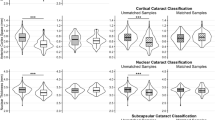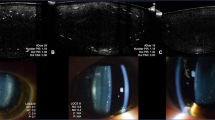Abstract
To investigate the levels and clinical relevance of serum β-amyloid (Aβ) in age-related cataract (ARC) patients. In the present study, an overall of 402 ARC patients and 450 normal controls were recruited between June 2018 and December 2019. Serum Aβ1-40 and Aβ1-42 concentrations were assessed by Elisa. The ARC patients were further grouped into several subgroups according to gender, age, types of ARC, and degree of lens opacity. The association of Aβ levels with ARC was determined using logistic regression models. ARC patients had significantly higher serum Aβ1-40 and Aβ1-42 levels than normal control. A similar finding was observed in subjects aged over 60 years. Serum Aβ concentrations were significant correlated with the degrees of lens opacity in C-ARC and N-ARC subjects. Logistic regression analyses revealed that serum Aβ1-40 (ORs = 1.202, 95% CI 1.077 to 1.341) and Aβ1-42 (ORs = 1.686, 95% CI 1.351 to 2.103) levels were potential risk factors for ARC. ARC patients have higher serum Aβ1-40, as well as Aβ1-42 levels, which may reflect an association between Aβ and ARC pathogenesis. Serum Aβ1-42 and Aβ1-40 levels are potential risk factors for ARC.




Similar content being viewed by others
References
Albers MW, Gilmore GC, Kaye J, Murphy C, Wingfield A et al (2015) At the interface of sensory and motor dysfunctions and Alzheimer’s disease. Alzheimer’s & dementia : the journal of the Alzheimer’s Association 11:70–98
Casparis H, Lindsley K, Kuo IC, Sikder S (2017) Bressler NM (2017). Surgery for cataracts in people with age-related macular degeneration, The Cochrane Database of Systematic Reviews
Chen W, Lin H, Zhong X, Liu Z, Geng Y et al (2014) Discrepant expression of cytokines in inflammation- and age-related cataract patients. PLoS ONE 9:e109647
Chylack LT, Jr., Wolfe JK, Singer DM, Leske MC, Bullimore MA, et al. (1993), The Lens Opacities Classification System III. The Longitudinal Study of Cataract Study Group. Archives of ophthalmology (Chicago, Ill : 1960) 111:831–836.
Cvekl A, Ashery-Padan R (2014) The cellular and molecular mechanisms of vertebrate lens development. Development (Cambridge, England) 141:4432–4447
Frederikse PH, Garland D, Zigler JS Jr, Piatigorsky J (1996) Oxidative stress increases production of beta-amyloid precursor protein and beta-amyloid (Abeta) in mammalian lenses, and Abeta has toxic effects on lens epithelial cells. The Journal of biological chemistry 271:10169–10174
Gali HE, Sella R, Afshari NA (2019) Cataract grading systems: a review of past and present. Curr Opin Ophthalmol 30:13–18
Goldstein LE, Muffat JA, Cherny RA, Moir RD, Ericsson MH et al (2003) Cytosolic beta-amyloid deposition and supranuclear cataracts in lenses from people with Alzheimer’s disease. Lancet (London, England) 361:1258–1265
Goralska M, Fleisher LN, McGahan MC (2017) Vitreous humor changes expression of iron-handling proteins in lens epithelial cells. Invest Ophthalmol Vis Sci 58:1187–1195
Grewal DS, Brar GS, Grewal SP (2009) Correlation of nuclear cataract lens density using Scheimpflug images with Lens Opacities Classification System III and visual function. Ophthalmology 116:1436–1443
Harding JJ (1998) Cataract, Alzheimer’s disease, and other conformational diseases. Curr Opin Ophthalmol 9:10–13
Hefter D, Ludewig S, Draguhn A, Korte M (2020) Amyloid, APP, and electrical activity of the brain. The Neuroscientist 26:231–251
Jack CR Jr, Knopman DS, Jagust WJ, Shaw LM, Aisen PS et al (2010) Hypothetical model of dynamic biomarkers of the Alzheimer’s pathological cascade. The Lancet Neurology 9:119–128
Lee CM, Afshari NA (2017) The global state of cataract blindness. Curr Opin Ophthalmol 28:98–103
Li G, Percontino L, Sun Q, Qazi AS, Frederikse PH (2003) Beta-amyloid secretases and beta-amloid degrading enzyme expression in lens. Molecular vision 9:179–183
Liu SS, Zhu SQ (2017), [Correlation between Alzheimer disease and cataract]. [Zhonghua yan ke za zhi] Chinese journal of ophthalmology 53:314–316.
Liu XF, Hao JL, Xie T, Malik TH, Lu CB et al (2017) Nrf2 as a target for prevention of age-related and diabetic cataracts by against oxidative stress. Aging Cell 16:934–942
Liu YH, Xiang Y, Wang YR, Jiao SS, Wang QH et al (2015) Association between serum amyloid-beta and renal functions: implications for roles of kidney in amyloid-beta clearance. Mol Neurobiol 52:115–119
Melov S, Wolf N, Strozyk D, Doctrow SR, Bush AI (2005) Mice transgenic for Alzheimer disease beta-amyloid develop lens cataracts that are rescued by antioxidant treatment. Free Radical Biol Med 38:258–261
Nagai N, Ito Y (2014) Excessive hydrogen peroxide enhances the attachment of amyloid beta1-42 in the lens epithelium of UPL rats, a hereditary model for cataracts. Toxicology 315:55–64
Parthasarathy R, Chow KM, Derafshi Z, Fautsch MP, Hetling JR et al (2015) Reduction of amyloid-beta levels in mouse eye tissues by intra-vitreally delivered neprilysin. Exp Eye Res 138:134–144
Swomley AM, Forster S, Keeney JT, Triplett J, Zhang Z et al (2014) Abeta, oxidative stress in Alzheimer disease: evidence based on proteomics studies. Biochem Biophys Acta 1842:1248–1257
Takagane K, Nojima J, Mitsuhashi H, Suo S, Yanagihara D et al (2015) Abeta induces oxidative stress in senescence-accelerated (SAMP8) mice. Biosci Biotechnol Biochem 79:912–918
Tang Y, Wang X, Wang J, Huang W, Gao Y et al (2016) Prevalence of age-related cataract and cataract surgery in a chinese adult population: The Taizhou Eye Study. Invest Ophthalmol Vis Sci 57:1193–1200
Totura AL, Bavari S (2019) Broad-spectrum coronavirus antiviral drug discovery. Expert Opin Drug Discov 14:397–412
Truscott RJW, Friedrich MG (2019) Molecular processes implicated in human age-related nuclear cataract. Invest Ophthalmol Vis Sci 60:5007–5021
Wilkins HM, Swerdlow RH (2017) Amyloid precursor protein processing and bioenergetics. Brain Res Bull 133:71–79
Xu J, Li D, Zheng T, Lu Y (2017) beta-amyloid expression in age-related cataract lens epithelia and the effect of beta-amyloid on oxidative damage in human lens epithelial cells. Molecular vision 23:1015–1028
Zhang K, Zhu X, Lu Y (2018) The proteome of cataract markers: focus on crystallins. Adv Clin Chem 86:179–210
Acknowledgments
This work was supported by grant No.81700824 National Natural Science Foundation of China (NSFC). Thanks are due to Yeran Wang for valuable advice and guidance.
Author information
Authors and Affiliations
Corresponding author
Ethics declarations
Competing Interests
The authors declare that they have no competing interests.
Additional information
Publisher’s Note
Springer Nature remains neutral with regard to jurisdictional claims in published maps and institutional affiliations.
Electronic supplementary material
Below is the link to the electronic supplementary material.
Rights and permissions
About this article
Cite this article
Li, C., Geng, Z., Yang, B. et al. Serum Aβ Levels are Associated with Age-related Cataract. Neurotox Res 39, 369–377 (2021). https://doi.org/10.1007/s12640-020-00325-7
Received:
Revised:
Accepted:
Published:
Issue Date:
DOI: https://doi.org/10.1007/s12640-020-00325-7




